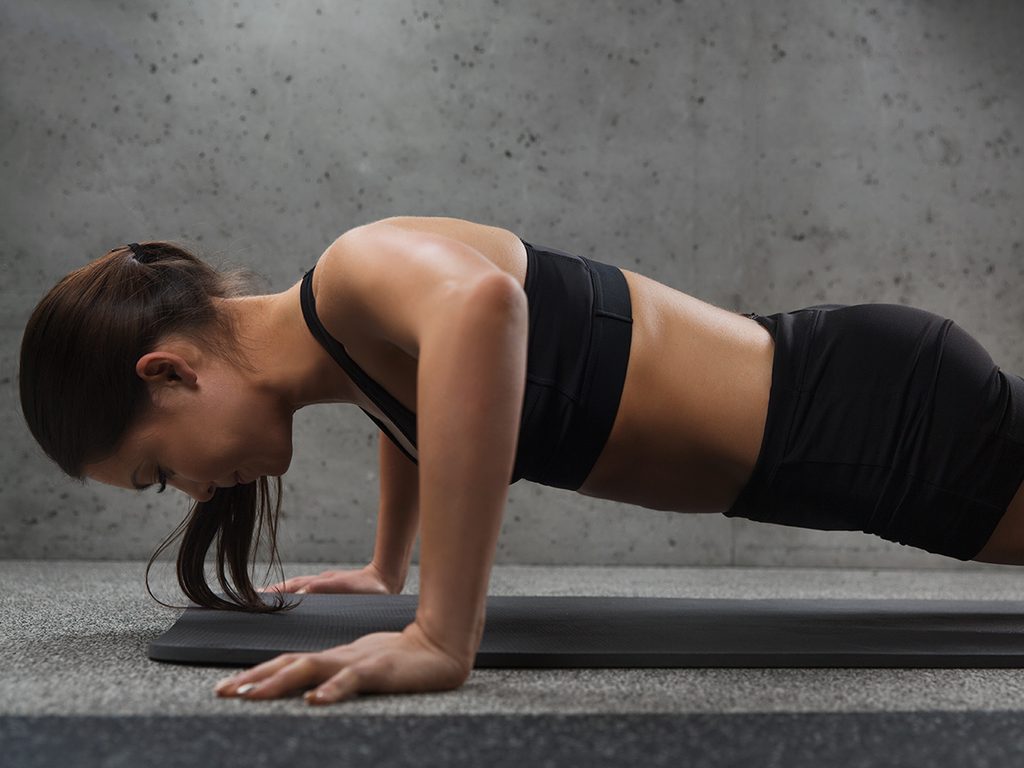How to Do Push-Ups Properly

This upper-body exercise is easy to master and modify.
Push-ups are a foundational exercise that work a ton of muscles in your upper body—they’re great for your pecs, core muscles, triceps, biceps and shoulders. According to Calgary-based personal trainer Whitney Dikoume, push-ups are a highly effective workout for everyone because of how many different muscles are engaged.
Here are five ways to push-up better and maximize the exercise.
1. Warm up your shoulders
You should warm up your whole body before any workout, but warming up your shoulders before push-ups is a must — it’ll make the workout more effective and protect you from injury. Start off with some shoulder stretches (like a cross-body shoulder stretch) and light shoulder/back exercises (like swimmers) before getting into a few sets of push-ups.
(Related: 6 Simple Exercises to Sculpt Your Shoulders)
2. Start with good posture
Good posture is especially important for push-ups because the exercise involves your shoulder joints. “If you’re doing push-ups incorrectly, you could end up damaging a lot of things,” explains Dikoume. “There are many nerves and tendons around the shoulders, and a lot of muscles involved.”
Dikoume points to two important spots to watch: your shoulders and your lower back. Once you’ve got the basic posture down (hands shoulder-width apart, feet hip-width apart behind you), make sure that your shoulders aren’t shrugged and that your lower back isn’t extended. When those two crucial areas aren’t in the correct position, your whole body can tighten up, leading to pinched nerves, sore shoulders and other injuries.
(Related: 5 Strength-Training Moves for Your Best-Ever Posture)
3. Work on an incline
If you’re a beginner, start with your hands higher than your feet. This means putting your hands up on a counter, or on a set of stairs, or on a chair with your feet on the floor. Dikoume suggests starting high and, once it gets too easy, go lower. Slowly work towards getting your hands on the ground.
While normal push-ups (with your body parallel to the ground) require you to lift your whole body up, incline push-ups use the same range of motion and muscles but eliminates some of the weight you need to move.
Kneeling push-ups are also great for beginners. Like incline push-ups, starting on your knees instead of your toes eliminates some of the weight you need to move and allows you to use your legs to help you lift.
(Related: 3 Activities to Keep You Fit While Working From Home)
4. Slow it down
If you’re a seasoned pro looking to maximize your push-up, pace yourself and go slower to put your muscles under more pressure, and work them more effectively. “Some of the high-performance athletes that I work with do push-ups where it takes them two to three seconds to go down to the floor, then they hold that position for two or three seconds,” says Dikoume. “And then they slowly push back up over two or three seconds, so the muscles are under tension that whole time.”
(Related: 11 Workout Moves You Can Do With Everyday Objects You Have at Home)
5. Destabilize your push-ups
Ready to level up? Dikoume suggests doing push-ups on an unstable surface, like a half-ball or a balled-up comforter, to challenge your muscles. The slight movement from the unstable surface will train you to be balanced and still as your body adapts to the shifting surface. Unstable push-ups also have the added benefit of being easier on your wrists, since you’re not pushing off the hard ground.
Next, check out the best arm exercises for women.




